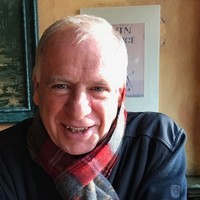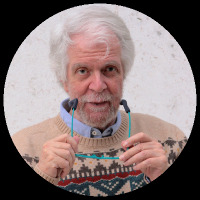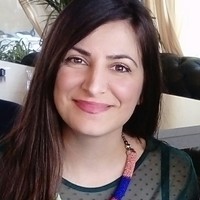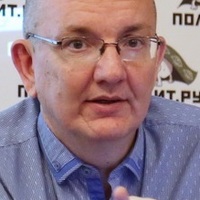
Božidar Jezernik
Božidar Jezernik (1951) is professor emeritus at the University of Ljubljana. He has taught ethnology of the Balkans, anthropology of globalisation and social memory and cultural heritage. He has conducted field research in Central and Southeast Europe. His main research interests are: History and culture of Central and Southeast Europe; construction of the "other"; life in extreme situations; politics of cultural heritage; nationalism, cultural heritage and collective memory.
In his most recent monograph Yugoslavia without Yugoslavs (Berghahn, 2023), he examines the history of the Yugoslav idea, its rise and fall. According to his findings, Yugoslavia disintegrated because its founding fathers did not create Yugoslavs after the state was founded in 1918, but instead turned peasants into Serbs in most of the country, while in the western part of the country they turned peasants into Croats or Slovenes.
In his most recent monograph Yugoslavia without Yugoslavs (Berghahn, 2023), he examines the history of the Yugoslav idea, its rise and fall. According to his findings, Yugoslavia disintegrated because its founding fathers did not create Yugoslavs after the state was founded in 1918, but instead turned peasants into Serbs in most of the country, while in the western part of the country they turned peasants into Croats or Slovenes.
He has published monographs on Italian, German and Yugoslavian concentration camps: Struggle for Survival (in Slovenian, Ljubljana, 1983 and 1997; in English, Ljubljana, 1999), Sex and Sexuality in extremis (in Slovenian, Ljubljana, 1993), Non cogito ergo sum (in Slovenian, Ljubljana, 1994; Serbian translation Novi Sad, 2012; Polish translation Naga Wyspa – Gułag Tity, 2013; revised Slovenian edition Goli otok – Titov gulag, 2013; German translation Titos Gulag auf der Insel Goli Otok, 2014), and Czech translation (Goli otok – Titův gulag, 2020).
His book of travelogues about the Balkans was published in Slovenian under the title Dežela, kjer je vse narobe (1998), and its expanded and revised English version was published under the title Wild Europe (London, 2004). It appeared in Turkish as Vahşi Avrupa (Istanbul, 2006), in Polish as Dzika Europa (Krakow, 2007), in Serbian as Divlja Evropa (Belgrade 2007), in Italian as Europa selvaggia (Torino 2010), in Albanian as Europa e egër (Tirana 2010), in Slovenian as Divja Evropa (Ljubljana 2011), in Bulgarian as Divata Evropa (Sofia 2013), in German as Das wilde Europa (Vienna 2015) and in Russian as Dikaja Evropa (Moscow 2017).
His book about coffee and coffee houses Kava – čarobni napoj (Ljubljana 2012) was honoured with the Gourmand Award “Best in the World” in Beijing (2014) and “Best in 20 Years” in Yentai (2015).
He is the editor of the proceedings of the international symposium Urban Symbolism and Rituals (in English, Ljubljana, 1997) and of monographs on terrorism The Words of Terror (in Slovenian, Ljubljana, 2002) and on the image of Gipsies in contemporary and historical narratives ‘Why do with us live Gipsies and not Roma People’ (in Slovenian, Ljubljana, 2006), on readings of the Other Ja i Drugoj v prostranstve teksta (in Russian, Perm', 2007), on the Balkans as Europe's Other (in English, Ljubljana, 2007), on the Slovenian bourgeoisie (in Slovenian, Ljubljana 2008), on imagining the 'Turk’ (in English, Newcastle 2010; in Serbian, Belgrade 2010; in Slovenian, Ljubljana 2011; in Albanian, Tirana 2010), on cultural heritage in identity (in Slovenian, Ljubljana 2010); and on museum presentations and manipulations (in Slovenian, Ljubljana 2010); on the politics of red letter days (in Slovenian, Ljubljana 2013); on heroes and celebrities in Slovenia (in Slovenian, Ljubljana 2013); and on the commemoration of the fallen soldiers of the First World War in the former Yugoslavia (in English, Ljubljana 2023).
Professor Jezernik has also published numerous articles in various national and international journals, such as Qualestoria, Etnološke sveske, Etnološki pregled, Traditiones, Etnolog, Časopis za zgodovino in narodopisje, Acta universitatis Lodziensis, Journal of the Gypsy Lore Society, Slavonic and East European Review, Food and Foodways, International Journal of Urban and Regional Research, Urban History, Ethnologia Europeae, Current Anthropology, EtnoAnthropoZoom, Alimenta Populorum, Acta Ethnographica Hungarica, Ethnologia Balkanica, Periferia, Museum Anthropology, Journal of Ethnology and Folkloristics, Łódzkie Studia Etnograficzne, and Antropologija.
In his most recent monograph Yugoslavia without Yugoslavs (Berghahn, 2023), he examines the history of the Yugoslav idea, its rise and fall. According to his findings, Yugoslavia disintegrated because its founding fathers did not create Yugoslavs after the state was founded in 1918, but instead turned peasants into Serbs in most of the country, while in the western part of the country they turned peasants into Croats or Slovenes.
In his most recent monograph Yugoslavia without Yugoslavs (Berghahn, 2023), he examines the history of the Yugoslav idea, its rise and fall. According to his findings, Yugoslavia disintegrated because its founding fathers did not create Yugoslavs after the state was founded in 1918, but instead turned peasants into Serbs in most of the country, while in the western part of the country they turned peasants into Croats or Slovenes.
He has published monographs on Italian, German and Yugoslavian concentration camps: Struggle for Survival (in Slovenian, Ljubljana, 1983 and 1997; in English, Ljubljana, 1999), Sex and Sexuality in extremis (in Slovenian, Ljubljana, 1993), Non cogito ergo sum (in Slovenian, Ljubljana, 1994; Serbian translation Novi Sad, 2012; Polish translation Naga Wyspa – Gułag Tity, 2013; revised Slovenian edition Goli otok – Titov gulag, 2013; German translation Titos Gulag auf der Insel Goli Otok, 2014), and Czech translation (Goli otok – Titův gulag, 2020).
His book of travelogues about the Balkans was published in Slovenian under the title Dežela, kjer je vse narobe (1998), and its expanded and revised English version was published under the title Wild Europe (London, 2004). It appeared in Turkish as Vahşi Avrupa (Istanbul, 2006), in Polish as Dzika Europa (Krakow, 2007), in Serbian as Divlja Evropa (Belgrade 2007), in Italian as Europa selvaggia (Torino 2010), in Albanian as Europa e egër (Tirana 2010), in Slovenian as Divja Evropa (Ljubljana 2011), in Bulgarian as Divata Evropa (Sofia 2013), in German as Das wilde Europa (Vienna 2015) and in Russian as Dikaja Evropa (Moscow 2017).
His book about coffee and coffee houses Kava – čarobni napoj (Ljubljana 2012) was honoured with the Gourmand Award “Best in the World” in Beijing (2014) and “Best in 20 Years” in Yentai (2015).
He is the editor of the proceedings of the international symposium Urban Symbolism and Rituals (in English, Ljubljana, 1997) and of monographs on terrorism The Words of Terror (in Slovenian, Ljubljana, 2002) and on the image of Gipsies in contemporary and historical narratives ‘Why do with us live Gipsies and not Roma People’ (in Slovenian, Ljubljana, 2006), on readings of the Other Ja i Drugoj v prostranstve teksta (in Russian, Perm', 2007), on the Balkans as Europe's Other (in English, Ljubljana, 2007), on the Slovenian bourgeoisie (in Slovenian, Ljubljana 2008), on imagining the 'Turk’ (in English, Newcastle 2010; in Serbian, Belgrade 2010; in Slovenian, Ljubljana 2011; in Albanian, Tirana 2010), on cultural heritage in identity (in Slovenian, Ljubljana 2010); and on museum presentations and manipulations (in Slovenian, Ljubljana 2010); on the politics of red letter days (in Slovenian, Ljubljana 2013); on heroes and celebrities in Slovenia (in Slovenian, Ljubljana 2013); and on the commemoration of the fallen soldiers of the First World War in the former Yugoslavia (in English, Ljubljana 2023).
Professor Jezernik has also published numerous articles in various national and international journals, such as Qualestoria, Etnološke sveske, Etnološki pregled, Traditiones, Etnolog, Časopis za zgodovino in narodopisje, Acta universitatis Lodziensis, Journal of the Gypsy Lore Society, Slavonic and East European Review, Food and Foodways, International Journal of Urban and Regional Research, Urban History, Ethnologia Europeae, Current Anthropology, EtnoAnthropoZoom, Alimenta Populorum, Acta Ethnographica Hungarica, Ethnologia Balkanica, Periferia, Museum Anthropology, Journal of Ethnology and Folkloristics, Łódzkie Studia Etnograficzne, and Antropologija.
less
Related Authors
Emir O. Filipović
University of Sarajevo, Faculty of Philosophy
Alejandra B Osorio
Wellesley College
Armando Marques-Guedes
UNL - New University of Lisbon
Danijel Džino
Macquarie University
Mariusz Filip
Adam Mickiewicz University in Poznań
Marc Buggeln
Europa-Universität Flensburg
Maja Vasiljevic
University of Belgrade
Mikhail (Mykhailo) Minakov
Woodrow Wilson International Center for Scholars
Sergey Abashin
European University at St. Petersburg
Juraj Marušiak
Slovak Academy of Sciences
InterestsView All (12)










Uploads
Papers by Božidar Jezernik
pitanje nego što je bio sam po sebi – orijentalno pitanje. Činjenica da
su Hercegovina i Bosna sa sve četiri strane okružene srodnim stanovništvom, s jedne strane, kao i rivalitet između velikih sila za prestiž, sa druge, davali su ustanku dimenziju mnogo širu od granica obje pokra
jine. Ustanak je u balkanskom „buretu baruta“ zapalio iskru i otvorio
takozvano Istočno pitanje.
Memory, however, is always selective and is never shaped in a vacuum, the ‘motives for memory are never pure.’ This can be clearly seen in the instance of one of the oldest public monuments in Ljubljana, Marian Column, which was, still at the end of the nineteenth century, when Carniola was otherwise ‘very poor in bronze sculptures,’ the only bronze monument in the land. Although it is a typical religious monument, designed in the manner of the seventeenth century, it clearly reflects the ideological and political circumstances at the time of its origin, while the modifications express the changes in the ideological and political conditions.
pitanje nego što je bio sam po sebi – orijentalno pitanje. Činjenica da
su Hercegovina i Bosna sa sve četiri strane okružene srodnim stanovništvom, s jedne strane, kao i rivalitet između velikih sila za prestiž, sa druge, davali su ustanku dimenziju mnogo širu od granica obje pokra
jine. Ustanak je u balkanskom „buretu baruta“ zapalio iskru i otvorio
takozvano Istočno pitanje.
Memory, however, is always selective and is never shaped in a vacuum, the ‘motives for memory are never pure.’ This can be clearly seen in the instance of one of the oldest public monuments in Ljubljana, Marian Column, which was, still at the end of the nineteenth century, when Carniola was otherwise ‘very poor in bronze sculptures,’ the only bronze monument in the land. Although it is a typical religious monument, designed in the manner of the seventeenth century, it clearly reflects the ideological and political circumstances at the time of its origin, while the modifications express the changes in the ideological and political conditions.